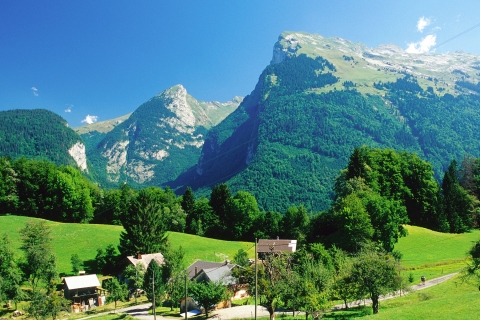PĂŠzenas Temperatures: Monthly Averages and Year-Round Insights
On this page, weâll explore PĂŠzenasâs temperature statistics in detail, including day and night variations and monthly averages. Weâll also compare the annual temperature to other cities in France.
Monthly Temperature Averages
Depending on the time of the year, temperatures range from comfortable to mild in PÊzenas. Typically, maximum daytime temperatures range from a comfortable 28°C in July to a moderate 12°C in the coolest month, February. Nights are cooler, with temperatures generally dropping to 5°C, particularly during the colder months.
The chart below illustrates the average maximum day and minimum night temperatures in PĂŠzenas by month:
The minimum temperature is often recorded between 4 AM and 6 AM, while the highest temperature is usually reached at 3 PM. During this time the sun's heating effect is the strongest. July, the cityâs warmest month receives 340 hours of sunshine.
The chart below shows the average temperature throughout the year:
February, the cityâs coldest month, sees about 61 mm of rainfall spread over roughly 10 days. It records 168 hours of sunshine of sunshine.
Annual Temperatures in France Compared
The map below shows the annual temperature across France. You can also select the different months in case you are interested in a specific month.
 very warm
very warm
 warm
warm
 pleasant
pleasant
 moderate
moderate
 cold
cold
 very cold
very cold
PĂŠzenas Temperatures Compared World Wide
PĂŠzenasâs average annual maximum temperature is 20°C. Letâs compare this with some popular tourist destinations:
Athens, Greece, experiences an average annual temperature of 23°C, with hot summers and mild winters typical of a Mediterranean climate.
Interlaken, Switzerland, the average annual temperature is significantly lower at 8°C, with mild summers and very cold winters.
In Shanghai, China, the annual average temperature is 21°C, offering warm summers and mild winters.
Melbourne, Australia, has a slightly cooler climate, with an average annual temperature of 20°C.
How does the temperature feel?
Humidity is an essential factor in how you experience temperature. When a warm period is accompanied by high humidity, it results in a higher perceived temperature. This is especially true when temperatures exceed 25°C, as it can cause greater discomfort.
On the other hand, in cooler months, especially when temperatures dip below 10°C, high humidity can intensify the cold. This makes the air feel much colder than it really is.
In PÊzenas, during the coolest month, February, you will experience 73% humidity, which is considered high. This is accompanied by an average maximum temperature of 13°C. In the warmest month, July, the humidity is 64% combined with an average maximum temperature of 28°C, which creates a high-feel temperature. Explore our detailed page on humidity levels for further details.
How are these Temperatures Measured?
Generally, temperature data depicting climate is usually given over a 30-year average in order to reduce short-term fluctuations and reveal better long-term trends in climate conditions.
This temperature data is taken from land-based thermometers, ocean buoys, ships, and satellites. These measurements are transmitted to weather stations and climate centers around the globe where they are processed, averaged, and analyzed in order to monitor the trends and create climate models.
Global Temperature Facts
Land Temperature: The average surface temperature of the Earth's land is about 14°C. It nevertheless shows extreme variations depending on many factors and location. For example, in hot deserts, like the Sahara, temperatures go up to 50°C during the day, while polar regions are generally below -30°C on average.
Fun fact: the temperature in deserts has the capability to drop radically during nighttime since there is no moisture contained in the air. Sometimes, the temperature might even drop over [30°C in just a few hours. This causes extreme contrast so that desert nights can sometimes feel really cool.
Sea Temperature: With a general average surface temperature of 17°C, the oceans are usually cooler than land. This highly contributes to the stabilization of the Earth's climate. They absorb heat slowly and release it just as gradually, which is why coastal areas experience milder weather.
Fun fact: the deep ocean is cold, even near-freezing, regardless of the temperature of the surface water above it. This is because sunlight does not reach the deep ocean.
Equatorial Regions: The direct sunlight at the equator will warm the Earth continuously all year round. This creates tropical rainforests in the Amazon and Congo basins with a high biodiversity in such regions. Equatorial areas have little seasonal variation of temperature but do experience distinct wet and dry seasons that influence their specific ecosystem.
Desert Regions: Temperatures in deserts are seasonal and quite variable. For example, winter nights in the North American Sonoran Desert are as cool as 0°C, but the summer days there have temperatures above 40°C. All deserts share the dry climate with annual rainfall typically below 250 mm.
Polar Regions: The Arctic and Antarctic poles experience extrem cold and long periods of complete darkness or daylight. Temperatures in the Arctic region during winter usually average about -30°C, while Antarctic temperatures can go far below -60°C, and sometimes even as low as -80°C in some interior regions.
Temperate Forests: Temperate forests are found in regions such as North America, parts of Europe, and East Asia. These areas have more temperate climates with marked seasons, such as warm summers and cold winters. The average temperatures range from 5°C to 22°C depending on the season.
Mountain Regions: Due to the height factor, there are high-altitude regions in countries like the Andes and Himalayan Mountains that have cool climates. For every rise of 1,000 meters in altitude, the temperature cools by approximately 6°C. With a large difference in height, these various climates range from temperate forests on the lower elevations to snow and glaciers on the highest peaks.
For more detailed information about PĂŠzenasâs weather, including monthly rainfall, sunshine hours, and humidity levels, visit our PĂŠzenas climate page.
Current temperature in PĂŠzenas
partly cloudy and no rain
overcast and no rain
broken clouds and no rain




